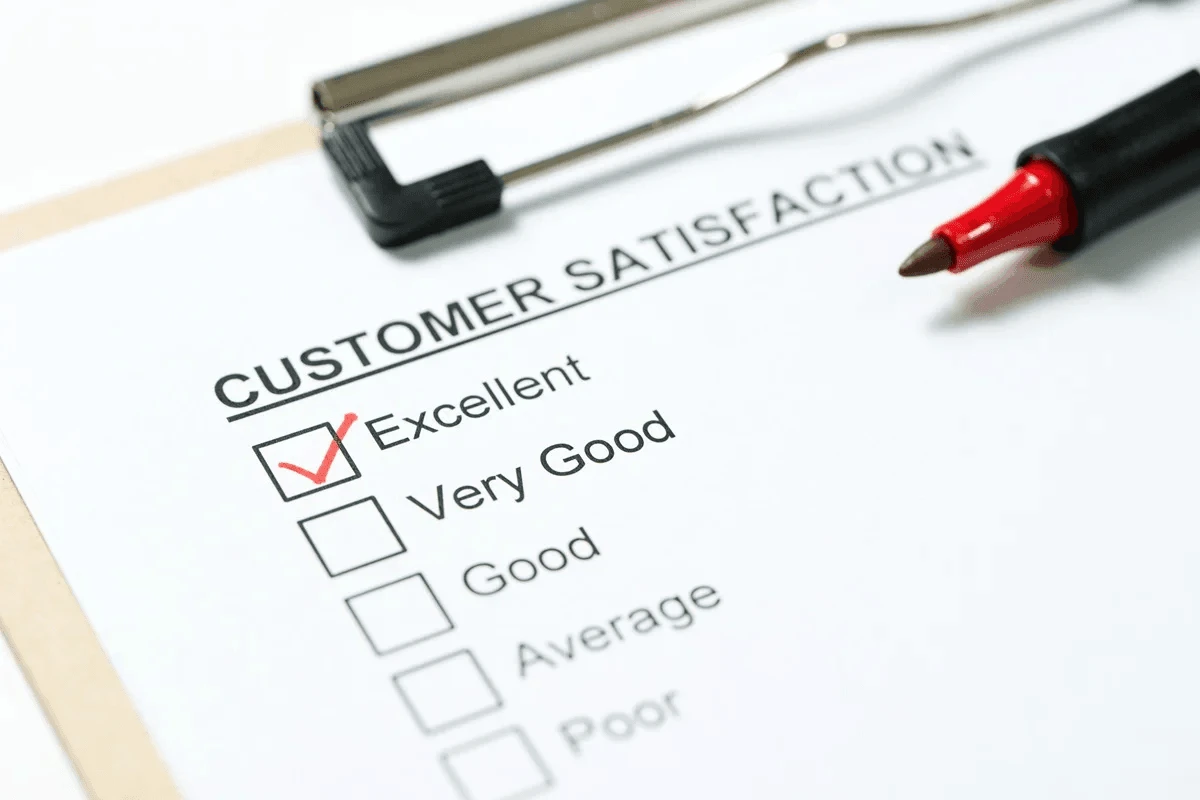Customer satisfaction metrics reveal what truly makes your customers happy. By understanding these key numbers, you can make smarter business decisions, grow your company, and create memorable experiences for your customers. But how do you get there?
To help you out, it’s important to know which customer satisfaction metrics every business should track. In this article, we’ll explore the most important tools and measurements, explain why they matter, and show you how to use them to improve the experience for all your customers. We’ll also cover key customer satisfaction measurement tools you can use to monitor and enhance satisfaction levels.
Let’s dive in!

Why Customer Satisfaction Metrics Matter to Your Business
Understanding why customer satisfaction metrics matter is key if you want your business to succeed and stand out. These numbers give you a clear picture of what your customers think and feel about your products and services. When you know this, you can make smarter choices that keep your customers coming back, improve your service, and help your business grow.
Here’s why these metrics are so important for you:
- They show how healthy your business is and where it can grow.
- They help you really get to know your customers and build strong, lasting relationships.
- They point out what’s working well and what needs fixing in your customer experience.
- They help you focus on customer service areas that can boost loyalty and keep customers around longer.
- They make sure your happy customers feel appreciated and heard, turning them into loyal fans.
- Monitoring customer satisfaction levels allows you to make data-driven decisions that directly impact your business success.

Key Customer Satisfaction Metrics to Track
To really understand and improve your customers’ satisfaction, you need to keep an eye on key satisfaction metrics. Tracking satisfaction and collecting specific data points from surveys or feedback are essential to measure customer experience effectively. These numbers give you a clear picture of how your customers feel about your products and services. By tracking these important customer satisfaction metrics, you can see the big picture of your customers’ experiences, spot areas that need improvement, and measure how loyal your customers are.
Here are the main customer satisfaction metrics you should focus on. These customer satisfaction metrics are used to measure customer satisfaction at different stages and help you measure customer loyalty, engagement, and overall experience:
- Customer Satisfaction Score (CSAT)
- Customer Effort Score (CES)
- Net Promoter Score (NPS)
- Customer Lifetime Value (LTV)
- Customer Health Score (CHS)
- Customer Retention Rate (CRR)
- Customer Reviews and Feedback.
Customer Satisfaction Score (CSAT)
Customer Satisfaction Score (CSAT) is a simple way to see how happy your customers are with their experience. A CSAT survey is a common customer satisfaction survey used to measure customer satisfaction after a customer makes a purchase or interacts with your business. You get this score by asking customers to rate their satisfaction with a product, service, or interaction through a survey. CSAT scores range from 0% to 100%, where a higher score means your customers are more satisfied. One great thing about CSAT is that you can customize the questions to focus on specific parts of the customer experience. This helps you find out exactly what’s working well and what needs improvement.
By tailoring your survey questions, you can pinpoint the areas where your satisfied customers are happy and identify areas for improvement. For example, if a certain part of your service gets a low CSAT score, it might be time to train your staff better or change how you do things. Paying attention to these details helps you fix problems quickly and make your customers feel valued, which keeps them coming back for more.
Customer Effort Score (CES)
Customer Effort Score (CES) helps you understand how easy or hard it is for your customers to interact with your business. A CES survey is used to measure customer effort during a customer service interaction, such as resolving an issue or obtaining support. It measures satisfaction by asking a simple question about how much effort a customer has to put in to complete a task, like making a purchase or getting support. You calculate CES by adding up all the scores and dividing by the number of responses. This score shines a light on any tricky spots where customers might be struggling, so you can smooth things out and make their experience easier.
CES surveys are valuable for identifying pain points in the customer journey. The best part? When customers don’t have to work hard to get what they want, they’re more likely to come back and tell others about you. However, CES does have a downside—it doesn’t show you which types of customers are having trouble, so you can’t segment the feedback. Still, it’s a powerful tool to spot and reduce customer effort, helping you boost satisfaction and build loyalty.
Net Promoter Score (NPS)
Net Promoter Score (NPS) helps you understand how loyal your customers are and how likely they are to recommend your product or service to others. An NPS survey is a key customer loyalty measurement tool, often compared against industry benchmarks to evaluate your performance. You get this score by asking one simple question: on a scale from 0 to 10, how likely are you to recommend us? Then, you subtract the percentage of unhappy customers (detractors) from the percentage of happy customers (promoters). This gives you a clear picture of your loyal fans, those who are just okay, and those who might need some extra attention.
NPS surveys are designed to capture feedback from your entire customer base, not just new customers. When your customers feel good enough to recommend you, it means your business is doing something right. Adding a follow-up question asking why they gave that score can give you even more helpful insights into how they really feel. This way, you can understand your customers better and make smart changes that keep them coming back and telling others about you.
Customer Lifetime Value (LTV)
Customer Lifetime Value (LTV) tells you how much money a customer is likely to bring to your business over the entire time they stay with you. LTV is calculated using purchase frequency, average purchase value, and average customer lifespan. You figure it out by multiplying the average amount they spend each time (average purchase or average purchase value), how often they buy (purchase frequency), and how long they keep coming back (average customer lifespan). Knowing your LTV helps you spot your best customers so you can focus your marketing and efforts on keeping them happy.
When you understand LTV, you gain valuable insights into customer behavior, which helps identify customers with high potential. Tracking LTV can also predict repeat business and customer churn rate, allowing you to improve retention strategies and reduce customer churn. By paying attention to those who bring the most value, you can create better experiences that keep them coming back again and again.
Customer Health Score (CHS)
Your Customer Health Score (CHS) shows how engaged your customers are and how likely they are to stop using your product or service. Keeping an eye on CHS helps you spot customers who might be unhappy or thinking about leaving, so you can step in and make things better before it’s too late. CHS is especially useful for identifying at risk customers who may need extra attention to prevent churn.
Tracking CHS also helps customer success teams find your most active and loyal customers—those who love your product and might be ready for more. These teams use CHS data to improve engagement, uncover growth opportunities, and share valuable insights across the entire company to inform process improvements and enhance overall performance. This way, you can focus on growing these relationships and turning good customers into great ones.
By watching your customers’ health, you can fix problems early, keep more people happy, and build a stronger, lasting connection with your audience.
Customer Retention Rate (CRR)
Customer Retention Rate (CRR) shows you the percentage of customers who keep coming back to use your product or service over time. When this number is high, it means your customers are happy and satisfied, and it also reflects their overall satisfaction with your product or service. If it’s low, it might be a sign that something needs fixing. You can use tools like Userpilot to make tracking this important number easier and faster.
Keeping your customers around is a smart move. When you focus on keeping your existing customers happy through loyalty programs and smooth experiences, you save money and build a stronger business. After all, happy customers are more likely to stay loyal and keep choosing you over the competition.
Customer Reviews and Feedback
Customer reviews give you a direct look at what your customers think and feel about your business. They help you spot exactly what’s working and what needs fixing. Analyzing customer reviews provides valuable customer insights, helping you understand customer perceptions and make informed decisions to improve their experience. When you pay attention to reviews and feedback, you get valuable clues on how to make your customers happier and solve any problems they face.
Taking the time to read and respond to customer reviews shows your customers that you care about their opinions. This builds trust and makes them feel valued, turning regular buyers into loyal fans. By staying engaged with your customers through their feedback, you create a stronger connection that keeps them coming back and sharing positive experiences with others.

How to Implement Customer Satisfaction Surveys
Implementing customer satisfaction surveys is a smart way to gather useful feedback from your customers. Here’s how you can do it effectively:
- Use CSAT scores to get quick feedback right after a customer interacts with your business, and include questions that measure customer service satisfaction through post-interaction surveys.
- Send surveys at the right moments during the customer journey. This helps you get honest answers and fix problems fast.
- Mix different question types, like open-ended and multiple-choice, to get a full picture of how your customers feel.
To make sure people complete your surveys, keep these tips in mind:
- Keep your survey short—ideally under 10 questions—so it doesn’t feel like a chore.
- Use simple language and avoid confusing words so everyone understands what you’re asking.
- Make sure your surveys work well on phones and tablets since many customers use mobile devices.
By following these steps, you’ll be able to measure how satisfied your customers really are and find the exact areas where you can improve their experience.
Tools for Measuring Customer Satisfaction
There are several handy tools you can use to easily keep track of your customer satisfaction metrics. These tools help you gather feedback, understand how your customers feel, and find ways to improve their experience. Here are six popular options you might want to try:
Qualtrics
Qualtrics is a powerful platform that lets you create custom surveys tailored to your business needs. It offers detailed analytics and reports that help you dig deep into customer feedback. Plus, it integrates smoothly with other customer service systems, making it easier for you to collect data from different channels and turn those insights into actionable steps to improve satisfaction.
Zendesk
Zendesk is more than just a ticketing system—it’s a tool that helps you capture customer feedback right after every support interaction. With built-in customer satisfaction features, it tracks how your support team is performing and highlights areas where you can improve. This way, you can quickly spot issues and make sure your customers always get the help they need.
SurveyMonkey
SurveyMonkey is a user-friendly survey tool that offers a wide range of templates for popular customer satisfaction surveys like CSAT, NPS, and CES. It provides real-time results and easy-to-understand analytics, so you can quickly see what your customers are thinking. Whether you want to run quick polls or in-depth surveys, SurveyMonkey makes it simple to gather valuable feedback.
Medallia
Medallia is designed for larger companies looking to capture customer feedback across multiple channels, including email, social media, and in-app surveys. It uses AI-powered analytics to identify trends and understand customer sentiment on a deeper level. This helps you spot potential problems early and improve overall customer satisfaction and loyalty over time.
HubSpot Service Hub
HubSpot Service Hub combines customer feedback tools with a powerful CRM system. You can easily send NPS and CSAT surveys and then track the results alongside your customer support tickets and interactions. This integration lets your team have a full view of the customer relationship, helping you respond faster and provide a more personalized experience.
Google Forms
Google Forms is a free and flexible tool that lets you create custom surveys quickly. While it doesn’t have all the advanced features of specialized platforms, it’s perfect for small businesses or when you want to gather initial feedback without any hassle. It’s easy to share, collect responses, and analyze the data right inside Google Sheets.

Common Challenges in Measuring Customer Satisfaction
Measuring customer satisfaction can be complex due to various obstacles businesses face. Understanding these challenges helps companies develop better strategies to gather accurate feedback and improve customer experiences. Key challenges include:
- Accurately identifying and understanding the evolving needs and expectations of customers, which can change over time.
- Prioritizing customer feedback effectively, as not every request can or should be acted upon.
- Selecting and using the appropriate tools and various communication channels to reach and satisfy customers efficiently.
- Maintaining consistent communication across multiple platforms, which can be overwhelming for businesses managing numerous customer service interactions.
- Handling unhappy customers with trained staff who respond empathetically and professionally to reduce negative impacts on the company.
- Managing service outages and keeping customers informed during these times to maintain satisfaction.
Addressing these challenges requires a dedicated approach, and this is where your customer service teams become essential partners in enhancing customer satisfaction.
The Role of Customer Service Teams in Enhancing Satisfaction
Your customer service team plays a big role in making your customers happy. By keeping a close eye on customer feedback and important satisfaction numbers, your team can spot patterns and make smart choices to improve how they help people. This regular check-in lets you fix problems early and adjust your approach so it fits what your customers really need.
When you quickly follow up on unhappy customers, you show them you care. Responding fast and solving their issues helps build trust and makes them more likely to stick with you. It sends a clear message that their opinions matter and you’re serious about making things right.
By weaving feedback into everyday work, your team can keep getting better at what they do. This way, you raise the bar on customer service all the time, turning more customers into happy, loyal fans who come back again and tell others about you.

Empower Your Customer Service with Reliable Outsourcing Solutions
To further enhance your customer satisfaction efforts, many businesses choose to outsource their customer service. Partnering with skilled external teams offers numerous advantages, such as access to specialized expertise, cost savings, and the ability to provide 24/7 support. This approach allows you to scale your customer service operations efficiently, adapt to changing demands, and focus more on your core business activities—all while maintaining high satisfaction levels among your customers.
At Outsource Philippines, we are dedicated to delivering exceptional customer service outsourcing solutions. Our highly skilled customer service professionals deeply understand diverse customer needs and consistently provide outstanding support. By working with us, you gain a strategic partner committed to improving your customer satisfaction, boosting customer loyalty, and driving your long-term business success.
Contact us today to discover how we can help elevate your customer experience and grow your business.







